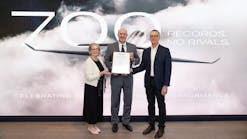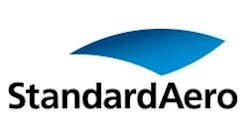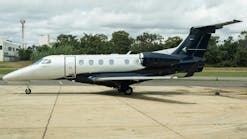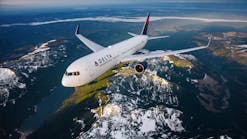Turbine Technology
By Joe Escobar
The TFE 731 engine is installed on many corporate aircraft airframes. In this article we will take a look at the fuel control system of one of the engines in that family — the TFE 731-2.
The engine fuel and control system on the TFE 731-2 engine performs several functions. It pressurizes the fuel that is routed through the engine, meters the fuel flow, and provides atomized fuel to the combustion section of the engine.
Fuel pump
The fuel pump provides high-pressure fuel to the engine fuel and control system. It consists of a boost pump element, fuel filter, differential pressure indicator (filter bypass valve), high pressure pump element, and relief valve.
A filter bypass valve on the fuel pump allows fuel to bypass the fuel filter if there is an excessive pressure drop across the filter element. A delta pressure indicator provides a visual indication by means of a pin extending from the valve before fuel bypassing actually occurs.
Fuel control
Fuel is metered by a hydromechanical fuel control. The fuel control contains a fuel shutoff section and a fuel metering section. The fuel control is mounted on the fuel pump. It is the connection point for the power lever control and provides fuel shutoff function. The fuel control also provides mechanical overspeed protection for the high-pressure rotor during normal engine operation.
The fuel control contains the fuel metering section, power lever input, shutoff valve, outlet pressurizing valve, overspeed solenoid, and a mechanical governor that functions as either an overspeed governor for the high-pressure rotor or provides manual control when the EEC/DEEC section of the fuel control system is deactivated. When activated, the EEC/DEEC controls fuel flow scheduling by electrically setting the metering section pressure drop within the fuel control in accordance with the power lever and engine inputs. In the event of electrical or EEC/DEEC failure (or by selection of the pilot) the fuel control operates independently in manual mode to provide for engine operation at reduced power at non-flat rated conditions.
Electronic engine control (EEC)
The EEC is a high-pressure rotor speed (N2) governor with provisions for fuel limits during acceleration and deceleration. The EEC performs governing, limiting, and scheduling functions in response to power lever and engine inputs. Inputs to the EEC are engine inlet pressure (PT2) and temperature (TT2), interstage turbine temperature (ITT) (TT5), high (N2) and low (N1) pressure rotor speeds and throttle position (power lever input).
The EEC provides an output current to the torque motor of the fuel control based on the input signals it receives. The EEC can also be controlled by an aircraft manual mode switch. A cockpit indicator shows manual mode operation in the event of loss of input power, EEC malfunction, or pilot deactivation of the EEC power.
During normal engine operation, the EEC/DEEC performs the function of thrust setting, speed governing, and acceleration and deceleration limiting through electrical control outputs to the fuel control based on received inputs.
N2 digital electronic engine control (DEEC)
The N2 DEEC on the TFE 731-2 engine utilizes digital circuitry providing less drift, fewer components and solder joints, and increased reliability when compared to earlier analog type designs.
The N2 DEEC requires several inputs from the engine. Low-pressure rotating group RPM is received from the N1 transducer. High-pressure rotating group RPM is transmitted from the N2 transducer. Interstage turbine temperature is received from the ITT harness probes. Inlet air temperature and pressure data is supplied by the combined TT2/PT2 sensor. Power lever position is received from a variable potentiometer which is located within the fuel control. All inputs are electrical with the exception of PT2. Inlet pressure is transmitted to the N2 DEEC through a pneumatic line connected between the inlet probe and the face of the N2 DEEC.
The outputs from the N2 DEEC go to the torquemotor, manual mode, and overspeed solenoids within the fuel control and to surge valve solenoids “A” and “B.”
The manual mode solenoid is energized whenever the N2 DEEC is operating in normal mode. This sets the mechanical N2 governor within the fuel control at 105 percent to act as an overspeed protection device. When the N2 DEEC transfers to manual mode this solenoid is de-energized which then allows the governor to be set or modulated by power lever position.
The N2 DEEC contains schedules for starting, idle, acceleration, takeoff power, climb/cruise, deceleration, and surge protection. Additional features include automatic starting fuel enrichment, 50 percent or 45 percent as applicable speed switch, ITT, and N1 limiting capability.
Aircraft takeoff power settings and N2 DEEC trim settings are specified in terms of N1 RPM. This is done because thrust is directly related to N1 RPM at a specific ambient condition. However, the N2 DEEC actually controls engine speed by governing N2 RPM. The N2 DEEC compares N2 RPM demanded by power lever position and ambient conditions to actual N2 RPM and generates an electrical signal which is sent to the torquemotor within the fuel control. This signal adjusts fuel flow to accelerate or decelerate the engine to achieve the desired speed. The N2 DEEC also monitors input parameters to determine the appropriate surge valve position.
Positioning the power lever to the maximum stop (fuel control at 120-122 degrees) results in maximum N1 RPM automatically adjusted for air temperature and altitude. This is accomplished by two schedules within the N2 DEEC referred to as the flat rate schedule and maximum speed schedule. These schedules are often abbreviated FR and Mn respectively. The FR schedule calculates an N2 for a specified air temperature and altitude that results in an N1 that limits thrust to approximately 3,500 pounds. However, at high air temperature and altitude this thrust level cannot be achieved prior to reaching either the maximum permissible ITT or N2 RPM. The Mn schedule calculates an N2 RPM for a specified air temperature that results in an N1 RPM that an airworthy engine can produce at or below the N2 or ITT limits (100 percent and 860C). The EFR could also be defined as the intersection point of the sea level FR or the Mn schedule.
The engine fuel control contains an overspeed solenoid which, when activated, closes the shutoff valve within the fuel control regardless of power lever position. This solenoid is activated by either of the two overspeed circuits. This solenoid will be energized should N1 exceed approximately 107 percent or N2 exceed approximately 109 percent. This overspeed shutdown feature is retained when the cockpit auto/manual switch is positioned to manual or when the N2 DEEC transfers to manual mode automatically, provided that the N1 and N2 monopole signals to the N2 DEEC are maintained.
These have been some basics of the TFE 731-2 fuel control system. Next month, we will cover some troubleshooting tips for this popular engine.





